Diseases of Litchi and their management
Diseases of Litchi and their management
Diseases are one of the constraints to the production of litchi fruits. They indirectly reduce yield by debilitating trees, and directly reduce yield or quality of fruit before and after harvest. Most of the diseases are caused by fungal pathogens. Monitoring is one of the important tools to keep track of the pathogens and their potential damage. Knowledge about diagnostic symptoms of various diseases and their management practices are hence provided here.
Leaf blight
Symptoms: A prominent disease in litchi nursery, also cause blight of panicles and developing fruits. The symptoms starts from tip of the leaf as light brown to dark brown necrosis that advances towards both the margins of the leaf leading to complete necrosis of the affected leaves that dries up subsequently. It is caused by Alternaria alternata.
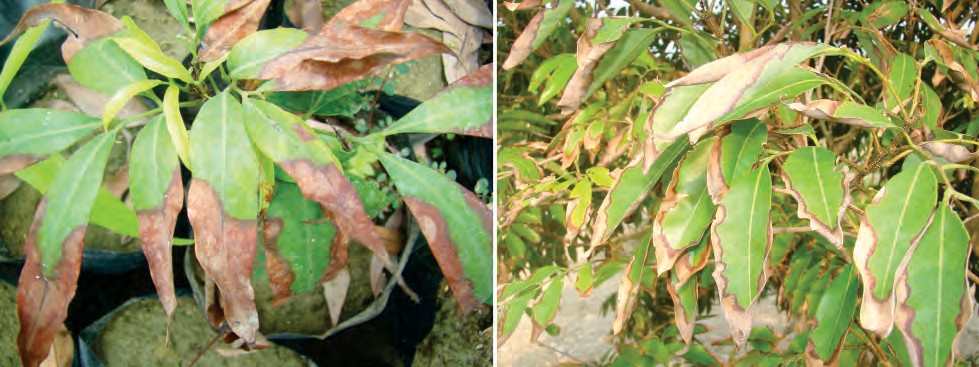
Management: Spray of copper oxychloride (0.1%) or mancozeb (0.15%) to prevent the disease. If disease severity increases, spray thiophanate methyl (0.14%) or chlorothalonil (0.15%) or difenoconazole (0.025%).
Twig blight
Symptoms: Death of leaves on new shoots, and a foliar blight and tip dieback which is difficult to separate. This leads to die-back of twigs in large numbers. The afflicted leaves give the impression as if they were scorched by sunrays. The major damage due to disease occurs during August-September and January-February. It is caused by Colletotrichum gloeosporioides and Gloeosporium sp.
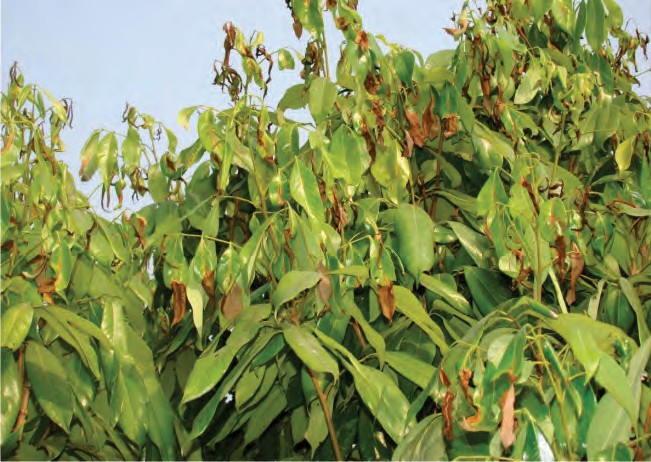
Management: Remove weeds from orchard which are alternative host for the pathogen. Prune diseased twigs and follow fungicidal spray recommended for leaf blight.
Panicle/lnflorescence and fruit blight
Symptoms: The leaf blight pathogen also cause panicle or inflorescence blight, and fruit blight at later stage. Blighting of panicles and fruits occurs. Panicles shrivel and dry up as a result of necrosis, while necrosis of the pedicel lead to complete drying of the rind of developing fruits. It is caused by Alternria alternata. Survival of the pathogen is through conidia on fallen leaves and also on senescing leaves under tree canopy.
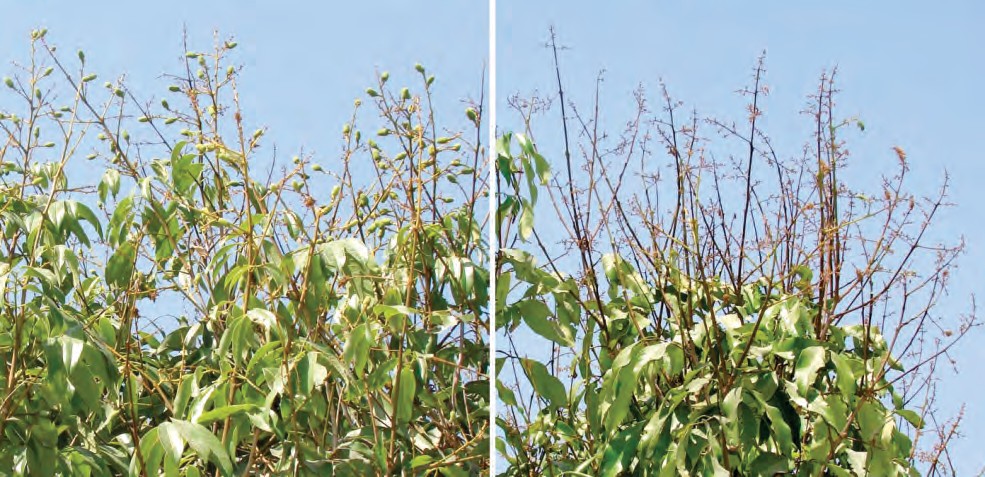
Management: Augment natural plant defense by soil application of microbes such as Trichoderma, Mycorrhiza etc. Spray thiophanate methyl (0.14%) or difenoconazole (0.025%) or azoxystrobin (0.023%) or carbendazim (0.1%). First spray should be done just after panicle initiation (before flower opening) and second spray at colour-break stage (20 days before harvest) of fruits.
Anthracnose
Symptoms: Brown pinhead lesions appear on fruits that later turn to circular dark- brown to black sunken lesions on mature fruits. Usually appear as superficial skin blemishes without affecting production and fruit quality but marketability is affected. It is caused by Colletotrichum gloeosporioides.
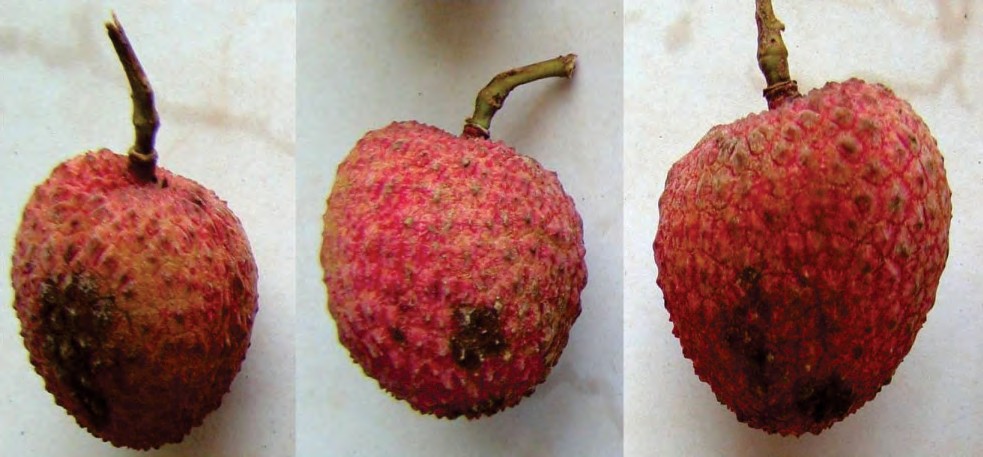
Management: Maintenance of orchard hygiene, through pruning of dead wood and removal of infected leaves, twigs and fruits help to reduce the incidence of the disease. Pre-harvest applications of fungicides at colour-break stage such as thiophanate methyl (0.14%) or chlorothalonil (0.15%) or difenoconazole (0.025%) or azoxystrobin (0.023%) offer good control. Pre-harvest spray of fungicide helps in extending post-harvest life.
Wilt
Symptoms: Young trees of litchi, often below five-year age, wilt in less than a week time. The first symptoms appear as yellowing of foliage, drooping leaves followed by gradual wilting and drying, leading to complete death of the plant within 4-5 days. It is caused by the fungus Fusarium solani.
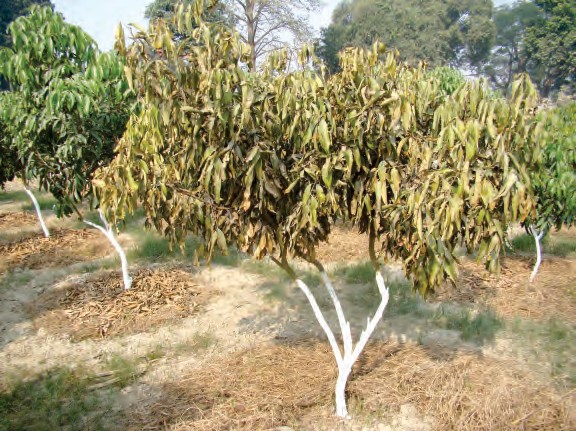
Management: Apply neem cake or castor cake @ 5-8 kg/tree along with recommended dose of fertilizer. Application ofbiocontrol agents like Trichoderma harzianum, T. viride, Pseudomonas fluorescens etc. has been proved effective in managing the disease. Application of Trichoderma can be done as follows: Apply 100-200 g of commercial formulation of Trichoderma per tree (according to age of tree) in active root zone. Mix it in 4-5 kg compost or FYM and spread on soil surface in a circular strip of about 30-40 cm wide at a place which is approximately two feet inside from the outer boundary of tree canopy. Ensure sufficient soil moisture by sprinkling water or give light irrigation. In absence of biocontrol agent, drench rhizosphere soil (active root zone) with hexaconazole (0.005%) or carbendazim(0.1%).
Algal leaf spot
Symptoms: Red, circular to semicircular spots (3.0-6.5 mm) appear mostly on the leaves and sometimes also on tender stems. Subsequently, orange yellow to pink velvety coating develops on the spots with formation of sporangia. In older leaves, the lesions turn light brown to brick-red. The disease appears in rainy season and continues till early winter. It is caused by Cephaleuros virescens. Pathogen survives on infected leaves. Zoospores are dispersed by rain and wind, and infect leaves through the stomata, with chains of algal cells developing in the leaftissue.
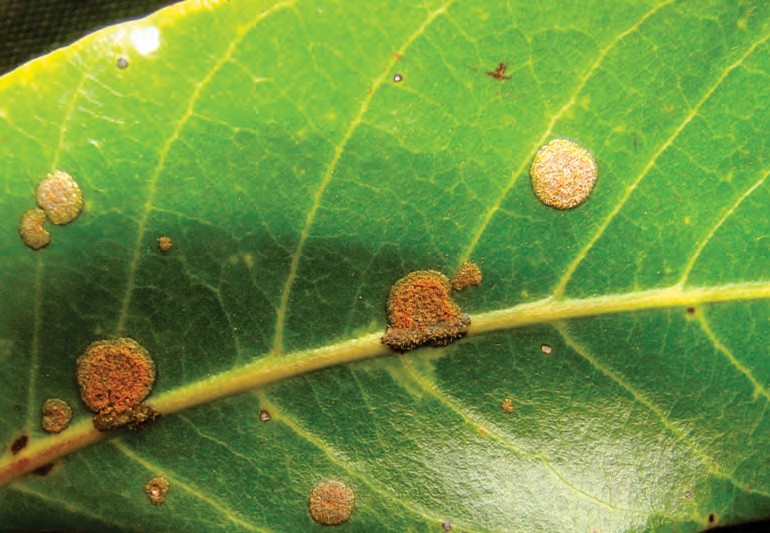
Management: Pruning improves tree ventilation and reduces disease. For management of this disease foliar spray of copper oxychloride (0.15%) may be done in July and October if severity increases.
Fruit rots
Symptoms: Initially perceptible on injured portion of fruits. The decayed areas get depressed and rot gradually penetrates deep into the pulp. Fruits emit an odour of fermentation. A wide range of fungi such as Alternaria, Colletotrichum, Aspergillus, Botryodiplodia and Penicillium sp. cause fruit rots, if fruits are not handled properly.
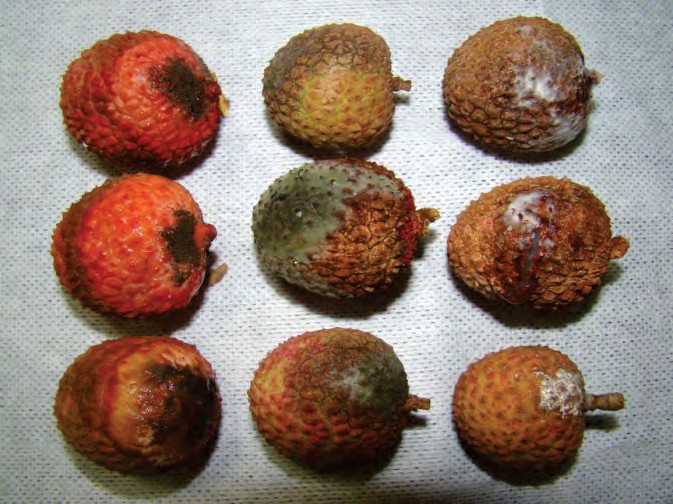
Management: Spray thiophanate methyl (0.14%) or carbendazim (0.1%) 15-20 days before harvest. Harvest fruits during early morning hour (4.00-8.00 AM) and avoid any mechanical injury to fruits. Prompt pre-cooling (temperature 4 °C, RH 85-90%) and maintenance of optimum temperature and relative humidity during transportation of fruits helps to prevent fruit rot. Fruits may be treated by sulphur fumes if allowed by importing countries. For this, fruits are placed in a closed chamber where 50-100 g sulphur per m3 of air space is burnt for 20-30 minute. For transportation, use corrugated fibre board (CFB) boxes of 2 kg capacity properly unitized for stacking. Other measures include biological control of decay pathogens and use ofa 10-15% CO2-enriched atmosphere for packaging.
Integrated management of major diseases
- Follow orchard sanitation by removing and destroying infected leaves.
- Augment natural plant defense by soil application of microbes such as Trichoderma, Mycorrhiza etc along with compost/ farm yard manure.
- Do preventive spray of copper oxychloride (0.1%) or mancozeb (0.15%)
- Spray thiophanate methyl (0.14%) or difenoconazole (0.025%) or azoxystrobin (0.023%) or carbendazim (0.1%) on appearance of first visual symptoms of disease.
- For panicle and fruit blight phase, one spray just after panicle emergence but before flower opening, and another spray 20 days before harvest (colour- break stage) of fruits.
- Pre-harvest spray of fungicides at colour- break stage help to prevent anthracnose and extend post-harvest life of fruits.
Last Modified : 8/11/2021
This topic provides information about Litchi: Inte...
